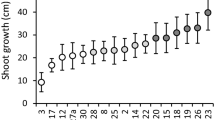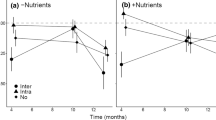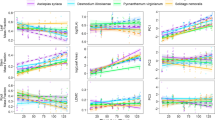Summary
Stellaria media and Poa annua were grown in a greenhouse over a wide range of mixed densities, and at three nutrient levels. The relative performances and interactions between individuals of both species were assessed over four interharvest growth periods using a new approach based on response functions (Connolly 1987). Species relative performances and interactions were complex, varying through time, and with mixed density and the nutrient environment. Studying the dynamics of the individual, interharvest growth periods led to a different, more accurate mechanistic interpretation of the final yield results, than did studying only one overall period of growth. Starting from considerably smaller seeds, Stellaria averaged twice as much biomass as young Poa plants by harvest 2 (H2). Stellaria achieved this early dominance with little suppression of Poa. Interspecific interference became more significant, and species proportional growth (K) became more similar in the second interharvest period (H2-3). During the final period of growth (H3-4), species relative performances largely reversed, Poa showing greater proportional growth than Stellaria. This superior performance by Poa occured despite individual plants being, on average, one half the size of Stellaria. Lack of interference early on is attributed to complementary above ground resource use resulting from species different shoot architectures (prostrate vs. cespitose). This complementarity disappeared as plants aged and became larger. The decline in Stellaria's superior relative growth performance through time was mainly due to its earlier and more substantial diversion of resources to reproduction. Species perception of each others influence, relative to themselves, as quantified by substitution rates, varied with both mixed density and nutrient environments. Stellaria consistently perceived Poa as less influential at higher nutrient levels than at lower levels. High nutrients favored the production of biomass for Stellaria more than for Poa, particularly in H2-3. While accelerating the switch to reproduction for Stellaria, nutrients did not increase its final reproductive yield per unit biomass. After H2, proportional growth for both species was relatively independent of frequency and density, indicating that a species acted as an aggregate of similarly behaving units of biomass whether arranged on many small, or a few large plants. An example shows that the conclusions from the response function approach applied within can be qualitatively different from those derived from a substitutive approach such as replacement series.
Similar content being viewed by others
References
Antonovics J, Levin DA (1980) The ecological and genetic consequences of density-dependent regulation in plants. Ann Rev Ecol Syst 11:411–452
Aspinall D, Milthorpe FL (1959) An analysis of competition between barley and white persicaria. Ann Appl Biol 47:156–172
Bazzaz FA (1987) Experimental studies on the evolution of niche in successional plants. In: Gray AJ, Crawley MJ, Edwards PJ (eds) Colonization, Succession and Stability, pp 245–272 Blackwell, Oxford
Bazzaz FA (1989) Plant-plant interactions in successional environments. In: Grace J (ed) Perspectives in Plant Competition, pp 239–263. Academic Press, New York
Blackman VH (1919) The compound interest law and plant growth. Ann Bot 34:353–360
Connolly J (1986) On difficulties with replacement series methodology in mixture experiments. J Appl Ecol 23:125–137
Connolly J (1987) On the use of response models in mixture experiments. Oecologia 72:95–103
Connolly J (1988) What is wrong with replacement series? TREE 3:24–26
Elberse WT, de Kruyf HN (1979) Competition between Hordeum vulgare L. and Chenopodium album L. with different dates of emergence of Chenopodium album. Neth J Agric Sci 27:13–26
Ellenberg H (1950) Landwirtschaftliche Pflanzensoziologie. Bd I, Unkrautgemeinschaften als Zeiger für Klima und Boden. Ulmer, Stuttgart
Ellenberg H (1978) Vegetation Mitteleuropas mit den Alpen in ökologischer Sicht. Ulmer, Stuttgart
Firbank LG, Watkinson AR (1985) On the analysis of competition within two-species mixtures of plants. J Appl Ecol 22:503–517
Fowler N (1981) Competition and Coexistence in a North Carolina grassland. II. The effects of experimental removal of species. J Ecol 69:825–841
Goldberg DE, Werner PA (1983) Equivalence of competitors in plant communities: A null hypothesis and field experimental approach. Am J Bot 70:1098–1104
Grime JP, Hunt R (1975) Relative growth-rate: its range and adaptive significance in a local flora. J Ecol 63:393–422
Harper JL (1961) Approaches to the study of plant competition. In: Milthorpe FL (ed) Mechanisms of Biological Competition. Symp Soc Exp Biol 15:1–39
Harper JL (1977) Population Biology of Plant. Academic Press, New York
Hutchinson CS, Seymour GB (1982) Biological flora of the British Isles, Poa annua L. J Ecol 70:887–901
Inouye RS, Schaffer WM (1981) On the ecological meaning of the ratio (de Wit) diagrams in plant ecology. Ecology 62:1679–1681
Kuppers M (1985) Carbon relations and competition between woody plants in a central European hedgerow. IV. Growth form and partitioning. Oecologia 66:343–352
Law R, Bradshaw AD, Putwain PD (1977) Life-history variation in Poa annua. Evolution 31:233–246
Milthorpe FL (1961) The nature and analysis of competition between plants of different species. In: Milthorpe FL (ed) Mechanisms of Biological Competition. Symp Soc Exp Biol 15:330–355
Nelder JA, Wedderburn RWM (1972) Generalized linear models. JRSS (A) 135:370–384
Newbery D, Newman EI (1978) Competition between grassland plants of different initial sizes. Oecologia 33:361–380
Newman EI (1983) Interactions between plants. In: Lange OL, Nobel PS, Osmond CB, Zielger H (eds) Encyclopedia of Plant Physiology. NS Vol. 12C, pp 679–710. Springer, Berlin Heidelberg New York
Parrish JAD, Bazzaz FAB (1985) Ontogenetic niche shifts in old field annuals. Ecol 66:1296–1302
Pearce SC, Gilliver B (1978) The statistical analysis of data from intercropping experiments. J Agric Sci Camb 91:625–632
Sinha SP, Whitehead FH (1965) Meiotic studies of British populations of Stellaria media (L.) Vill., S. neglecta Weihe and S. pallida (Dumort.) Pire. New Phytol 64:343–345
Sobey DG (1981) Biological flora of the British Isles, Stellaria media (L.) Vill.. J Ecol 69:311–335
Wit CT de (1960) On competition. Versl Landbouwk Onderz 66:1–82
Author information
Authors and Affiliations
Rights and permissions
About this article
Cite this article
Connolly, J., Wayne, P. & Murray, R. Time course of plant-plant interactions in experimental mixtures of annuals: density, frequency, and nutrient effects. Oecologia 82, 513–526 (1990). https://doi.org/10.1007/BF00319795
Received:
Accepted:
Issue Date:
DOI: https://doi.org/10.1007/BF00319795




